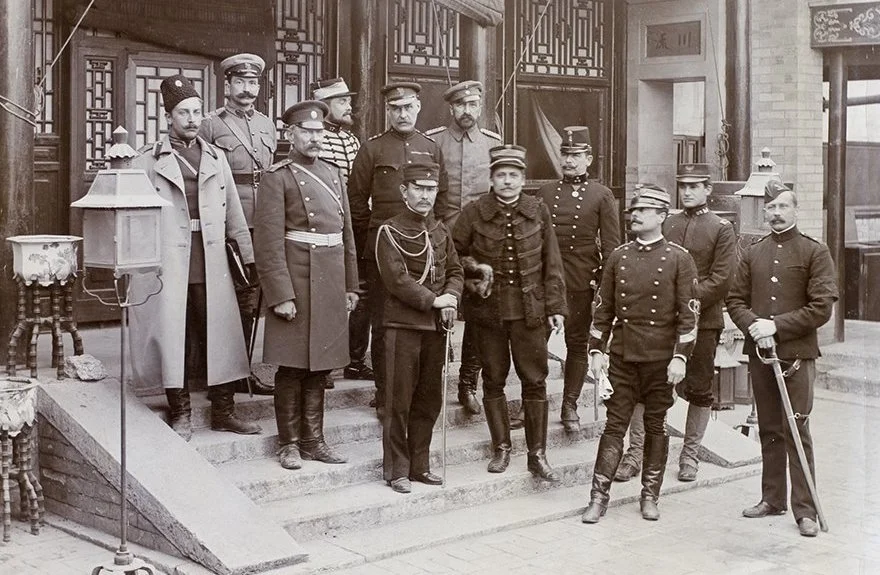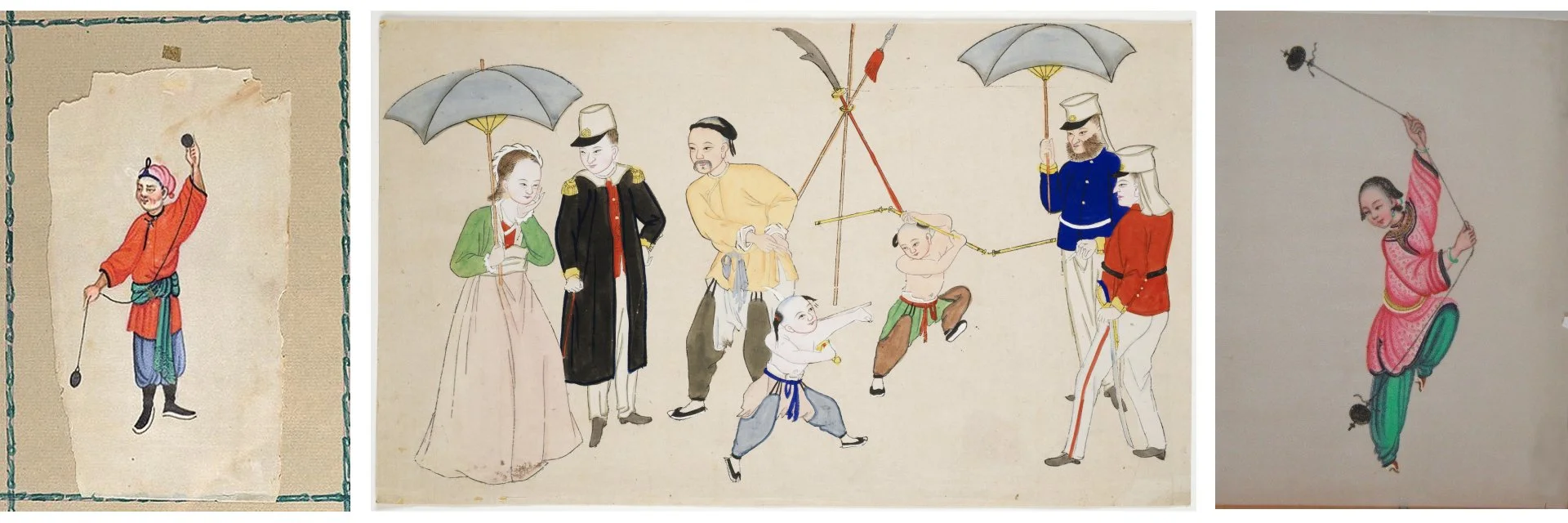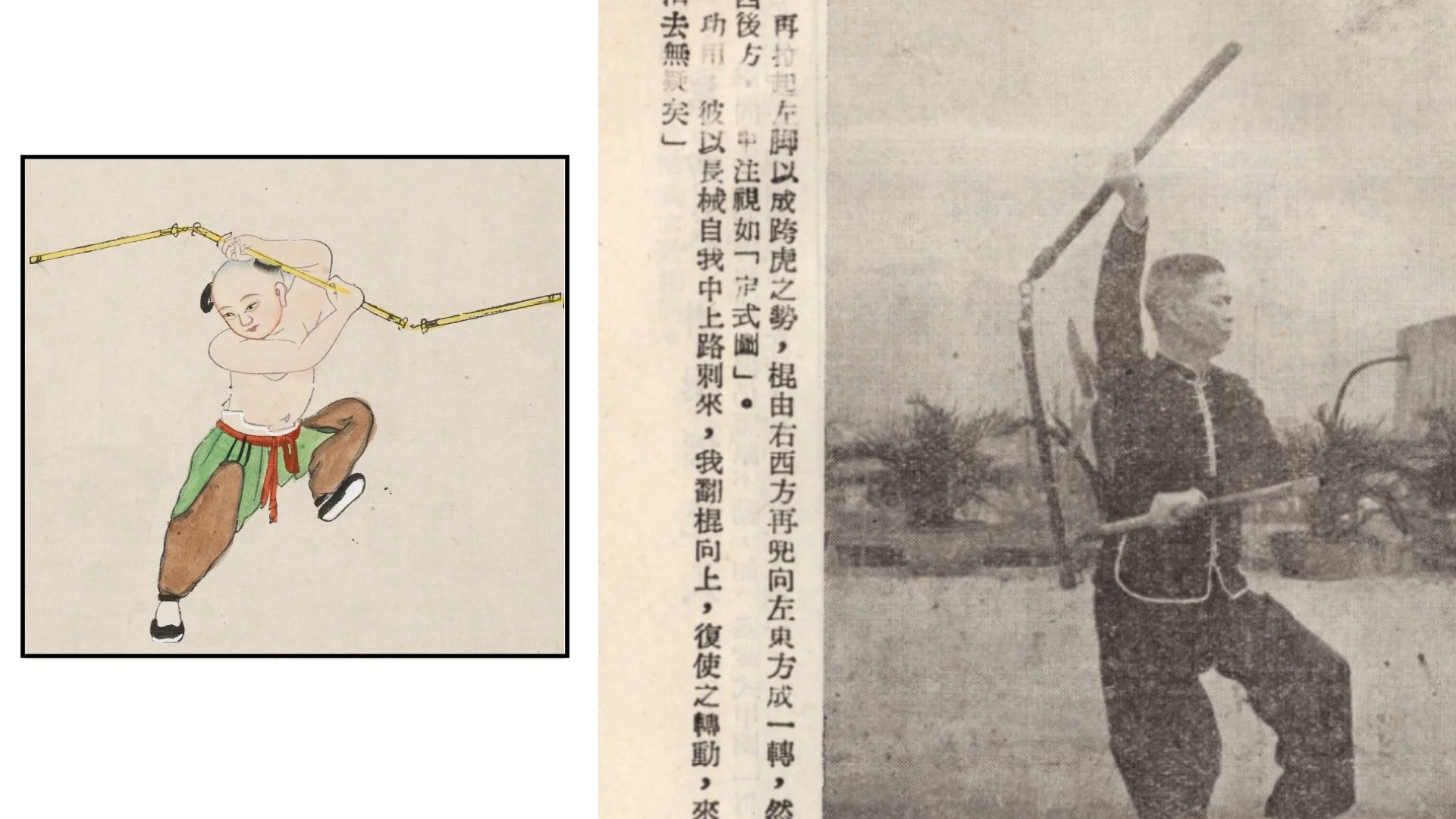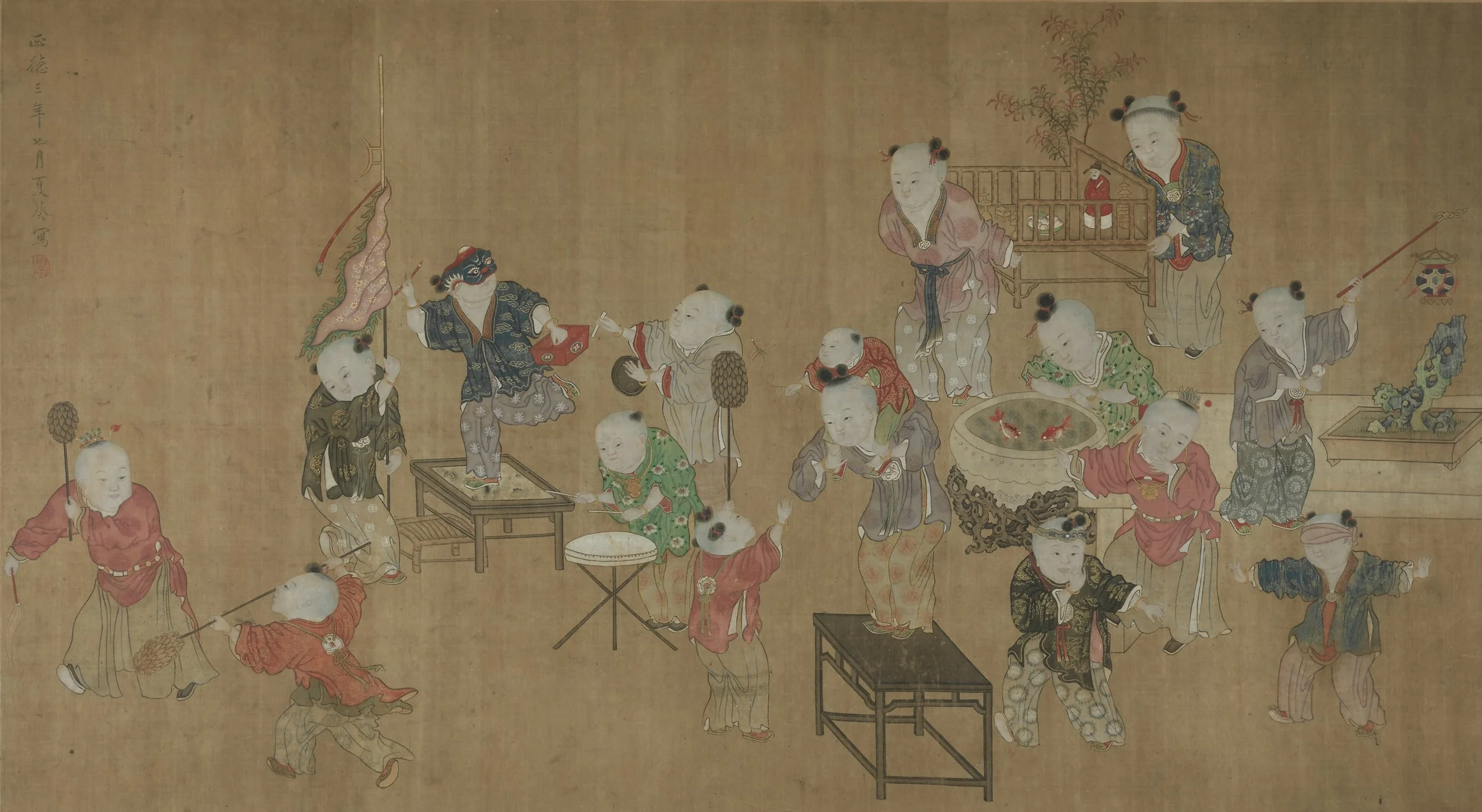A Newly Discovered Print depicting Chinese Martial Arts
Above Two children give a street performance weapons demonstration with the three section staff, saber and guǎi (拐 lit. “crutch”, more commonly known in the west by its Japanese name, tonfa). Their supervisor gestures proudly while the foreigners from Europe look on in delight. Polearms standing in the background hint at other routines. Late 1800’s - Early 1900’s?
It’s always exciting when an old depiction of Chinese martial culture is newly discovered. It reminds us that there is still lots more to be discovered (and so much we have already lost!). This particular print I happened upon while browsing images from the Liszt Collection, a massive archive of over a million engravings, photographs and prints (mostly from the 19th century) that all started when Gizella Schwarz (1877–1962) began collecting a few Liszt prints.
Above Various uniforms from the 1890’s compared to those depicted in the print. If I was forced to assign a nationality to each soldier depicted off the top of my head, from right to left we would have a member of the French Foreign Legion, an American soldier and a Japanese soldier. The woman’s outfit is generically European. The artist’s depiction of each foreigner may have simply been a loose and fast representation of European dress, not necessarily concerned with hyper specific colors or details. I’ve resisted the urge to spend time hunting for historic wardrobes exactly aligning with those portrayed in the print, but I am open to being shown examples of their existence should a specialist in period dress wish to contact me. As a side note, the only adult Chinese in the print (not pictured above) wears traditional dress for the period and a queue hairstyle, with both the Chinese boys starting on their own.
The print was dated 1754 in the listings, which seemed immediately incorrect to me for a number of reasons. In the interest of brevity I’ll elaborate on one: the wardrobe (not to mention presence) of the various foreign spectators. My knowledge of late 19th/early 20th European wardrobe is a little rusty (read “non-existent”), but a quick search confirms that these uniforms resemble something more comparable to the depictions sourced from the close of the 19th century. The print itself was probably created anywhere from the 1890’s to the first decade of the 1900’s.
Above: General Staff of the Eight Nation Alliance in China, circa 1900-1901. The Boxer Rebellion of 1900 saw the armies of eight countries marching on Chinese soil, hailing from Britain, the United States, Australia, India, Germany, France, Austria-Hungary, Italy and Japan.
It is not uncommon to find paintings (or in this case, hand-colored woodblock prints) such as these depicting merely a single performer with no other subjects in sight; here however we are greeted to an entire charming scene full of character. The children lean, leap and twist their arms, dynamically in motion rather than statically posing. One spectator seems more interested in his female companion (who was depicted with western style twin braids). A spectator rests his hand on a western saber; that sabers and clothing from both cultures are simultaneously presented provides for more comparison and contrast between the East and West, heightening interest within the scene.
Above Left and Right What we typically find with works of this style/era: the lone street performer devoid of context or even partner. Above Center An entire lively scene. What an exciting find!
As a pleasant bonus, the weapons utilized in this scene are all present in my own martial lineage (Wong Honfan’s lineage of Praying Mantis Kung Fu). Forms and techniques in this art exist for the staff, spear and guandao that appear standing in the background of this printed incident. The three section staff, arguably a most visually interesting weapon, conjured for me in my mind images from Wong Honfan’s Praying Mantis book on the unusual weapon.
Above Right Tiger Tail Three Section Staff, Wong Honfan’s historic manual was one of the very first on the weapon’s form and applications. The photos within it are nothing short of iconic, depicting the master wielding the weapon on the rooftops of Hong Kong. Above Left Two section flail weapons are present in Ming Dynasty manuals, but depictions of the three section staff specifically are very rare. Could this be one of the oldest depictions?
Perhaps even rarer than the three section staff wielder is the historic portrayal of the kung fu practitioner utilizing both saber and guai simultaneously. This atypical combination of weapons was also practiced in Wong’s Mantis school; there are photos of both Wong’s students practicing this pairing as well as photos of Wong himself (both young and in his older days) drilling these weapons. Special thanks to Wong Ngai Ying (黃毅英) for sharing these rare images.
Above Left and Right Wong and students drill an unusual weapon pairing which allows the practitioner to cut at long range, block and bludgeon at short range. Photos Courtesy of hfwong-mantis.com.
The final element which makes this print such a unique find? That the martial arts practitioners within are young children. Historical paintings and prints of children practicing Chinese martial arts are quite few and far between.
Above: “Children at Play” (嬰戲圖), a painting from 1508. Note the blade atop the flag pole. Image courtesy of www.clevelandart.org.
To be sure, children were often depicted: “100 boys [at play]” was an entire pictorial theme that was quite popular in traditional Chinese painting. Featuring literal hordes of children engaged in every kind of game imaginable, sometimes depictions of children with toy weapons arise within the crowd. Of course this kind of self absorbed play is in stark contrast to the setting of our new found print: that of purposefully exhibiting paired weapon exercises with a partner under the onlooking gaze of spectators who would toss a coin should they be thoroughly impressed. While these paired demonstrations no doubt featured dramatic flair, they also had their roots in real martial applications.
Above Left A deadly young Mantis warrior strikes a pose. Above Right Children in Kung Fu: two brothers join the local Chin Woo school to study Praying Mantis Fist. Michael Lee Kok Seng, right and Richard Lee Hong Leng, left, circa 1959. Special Thanks to Michael Lee Kok Seng for sharing these photographs.
What more can I say than thank you for reading and enjoy this new found print! May the research, practice and sharing of this art continue. All the Best.
Alexander Petty holds a Bachelor of Arts in Music Composition and a Master of Arts in History. He is a 10th generation inheritor in the Chinese martial art 螳螂拳 (Praying Mantis Fist), and has successfully utilized his skills in full-contact matches (watch his most recent fight here). A designer, he has sold thousands of decks of custom-made playing cards, available here. Be it piano or card flourishing, martial arts or history, one of Alexander’s goals includes sharing the arts he has explored with all who are willing to learn. Reach out for private lessons here.
This article was first posted March 5th, 2022.









